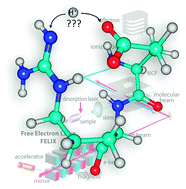Gas-phase salt bridge interactions between glutamic acid and arginine†
Abstract
The gas-phase side chain–side chain (SC–SC) interaction and possible proton transfer between glutamic acid (Glu) and arginine (Arg) residues are studied under low-temperature conditions in an overall neutral peptide. Conformation-specific IR spectra, obtained with the free electron laser FELIX, in combination with density functional theory (DFT) calculations, provide insight into the occurrence of intramolecular proton transfer and detailed information on the conformational preferences of the peptides Z-Glu-Alan-Arg-NHMe (n = 0,1,3). Low-energy structures are obtained using molecular dynamics simulations via the simulated annealing approach, resulting in three types of SC–SC interactions, in particular two types of pair-wise interactions and one bifurcated interaction. These low-energy structures are optimized and frequency calculations are performed using the B3LYP functional, for structural analysis, and the M05-2x functional, for relative energies, employing the 6-311+G(d,p) basis set. Comparison of experimental and computed spectra suggests that only a single conformation was present for each of the three peptides. Despite the increasing spacing between the Glu and Arg residues, the peptides have several types of interactions in common, in particular specific SC–SC and dispersion interactions between the Arg side chain and the phenyl ring of the Z-cap. Comparison with previous experiments on Ac-Glu-Ala-Phe-Ala-Arg-NHMe as well as molecular dynamics simulations further suggest that the pairwise interaction observed here is indeed energetically most favorable for short peptide sequences.


 Please wait while we load your content...
Please wait while we load your content...